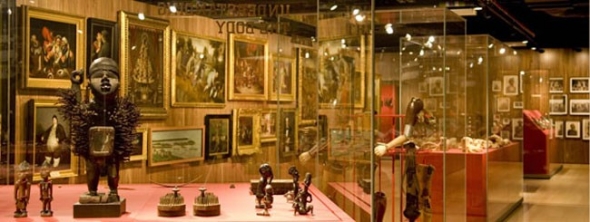On the Tuesday we immersed ourselves in exhibitions again and headed first for the British Library for the map exhibition entitled ‘Magnificent Maps: Power, Propaganda and Art’ which brings together 80 of the largest, most impressive and beautiful maps ever made, from 200 AD to the present day.
On the way there we past an old church with a really terrible art exhibition in it’s crypt. The exhibition space was amazing, shame the same couldn’t be said about the work. The crypt was protected and watched over by 4 mighty statues and the building was covered in lovely little details:
But forget that exhibition – it’s not worth a look-in. I highly recommend you go and see the map exhibition though if you’re in London – it’s on until the 19th September.

We knew this exhibition was on because of the recent TV series The Beauty of Maps and the website links directly to the website for the exhibition. We both love maps and it was amazing to see such a huge collection of different maps of all different sizes and styles. From Queen Mary’s tiny little dolls-house miniature atlas which would site in the palm of your hand to the massive 17th-century Klencke Atlas, which was taller than us. You can find out more about the exhibition and the maps by visiting the website.
We then popped over to the Wellcome Trust to see the exhibition entitled Skin. The exhibition invites you to:
re-evaluate the largest and probably most overlooked human organ. We consider the changing importance of skin, from anatomical thought in the 16th century through to contemporary artistic exploration. Covering four themes (Objects, Marks, Impressions and Afterlives), ‘Skin’ takes a philosophical approach. It begins by looking at the skin as a frontier between the inside and the outside of the body. Early anatomists saw it as having little value and sought to flay it to reveal the workings of the body beneath. The exhibition then moves to look at the skin as a living document: with tattoos, scars, wrinkles or various pathologies, our skin tells a story of our life so far. Finally, the skin is considered as a sensory organ of touch and as a delicate threshold between life and death.
Watch this:
I loved the anatomical illustrations of as well as these detailed diagrams illustrating various surgical stitches and wound ties. The illustrations are so beautifully executed:

The medical technique of closing a wound and facilitating skin healing is crucial. Although suture (or stitching) materials and aspects of the technique have changed, the principles remain the same: closing, supporting and strengthening wounds, and minimising risks of bleeding and infection. The choice of suture technique depends on the type and location of the wound, the thickness of the skin and the desired cosmetic result.
Find out more about the exhibition here.
Upstairs from this exhibition was ‘Medicine Man’ – an exhibition that reunites a cross-section of extraordinary objects from Henry Wellcome’s collection, ranging from diagnostic dolls to Japanese sex aids, and from Napoleon’s toothbrush to a lock of George III’s hair.

It also provides a very different perspective on some of our own obsessions with medicine and health. This is a permanent exhibition and is definitely worth a visit – very well laid out with lots of drawers and cubby holes full of surprises and tales.
Even the walls within the toilets were educational:









